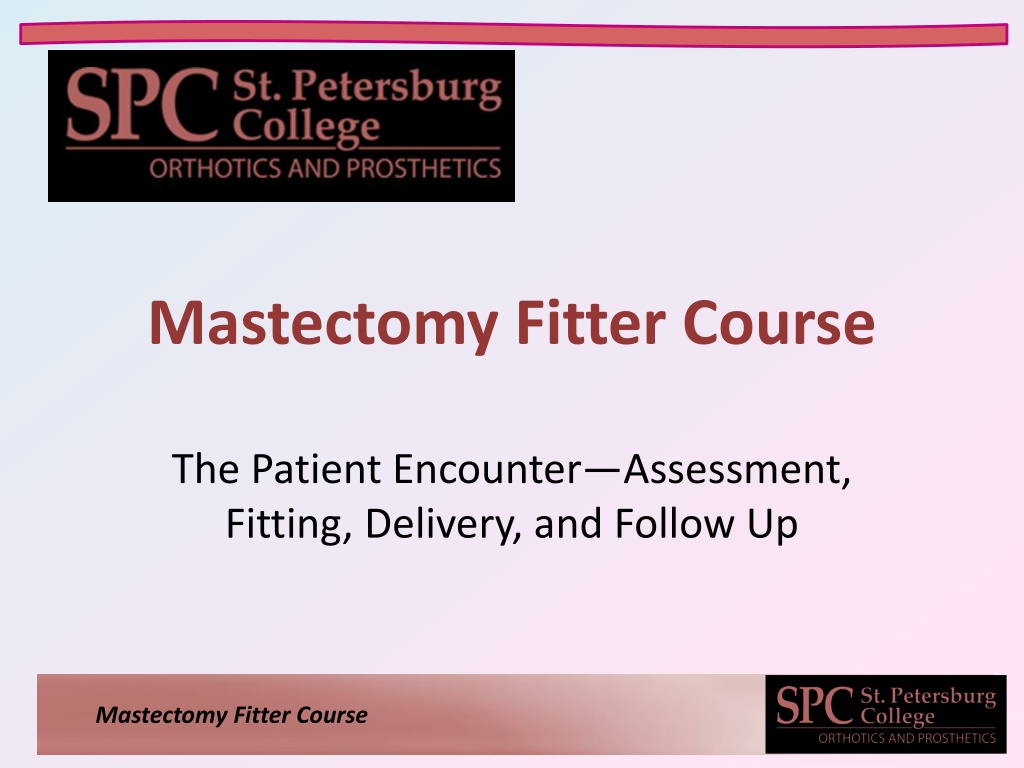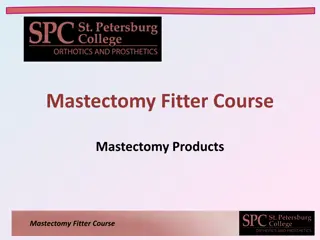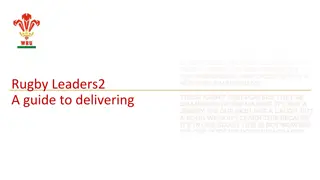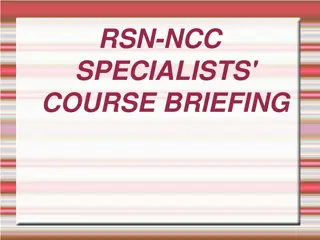Comprehensive Mastectomy Fitter Course Overview
This comprehensive mastectomy fitter course covers patient encounters, assessments, fittings, deliveries, and follow-ups. It includes defining medical terminology, addressing psychosocial issues, creating treatment plans, fitting prosthetics, and ensuring successful patient outcomes. The course also emphasizes initial evaluations, fitting room ethics, patient history review, and essential steps for effective care.
- Mastectomy Fitter Course
- Patient Assessment
- Prosthetic Fittings
- Healthcare Professional
- Treatment Plan
Download Presentation

Please find below an Image/Link to download the presentation.
The content on the website is provided AS IS for your information and personal use only. It may not be sold, licensed, or shared on other websites without obtaining consent from the author. Download presentation by click this link. If you encounter any issues during the download, it is possible that the publisher has removed the file from their server.
E N D
Presentation Transcript
Mastectomy Fitter Course The Patient Encounter Assessment, Fitting, Delivery, and Follow Up Mastectomy Fitter Course
Objectives 1. 2. Define medical terminology as it relates to mastectomy. Explain basic psychosocial disorders and issues that may be encountered with the mastectomy patient. Outline the steps to performing a patient assessment including patient prescription and referral review, patient history, evaluation and measurement, healthcare professional consultation, and patient referral. Outline the steps to compose a patient specific mastectomy treatment plan including interpreting the patient evaluation, making a prosthetic recommendation, and formulating goals and expected outcomes. Outline the steps necessary to implement the treatment plan including selecting and assemble the appropriate prosthetic design and materials, consult with manufacturers, assess the fit, and educate and counsel the patient. Utilize a follow-up plan that ensures successful patient outcomes in regards to mastectomy prosthetic treatment including modifications, continual patient assessment, soliciting patient feedback and development of long term plans and prognosis. 3. 4. 5. 6. Mastectomy Fitter Course
EVALUATION Mastectomy Fitter Course
Initial Impression Your initial evaluation, or sometimes a pre- consultation, will be the first and only chance you have to establish rapport with your patient and start building trust! Make comfortable eye contact Maintain a professional appearance (clean and covered from all angles and positions) Wear a photo ID with credentials Limit fragrances, hairsprays, etc. Hands clean, nails short Mastectomy Fitter Course
Fitting Room Ethics Don'ts Diagnose Suggest a prognosis Offer medical advice outside of your scope Set unrealistic expectations Try to Relate Make comparisons with previous patients conditions Do s Be Helpful Offer choices/options Explain features (positives and negatives) Refer back to physician or other member of healthcare team when necessary Mastectomy Fitter Course
Patient History After a patient has come to their appointment with their prescription and filled out the appropriate paperwork, you as a mastectomy fitter begin your evaluation. Mastectomy Fitter Course
Patient History, continued After introducing yourself and making sure the patient is comfortable in the fitting room start by gathering some background information. Patient s height and weight Exact diagnosis, date of onset and/or date of surgery Patient s age, DOB and prescribing physician (if you do not already have this information) What are they here for? Bras, Breast Forms, Accessories? Mastectomy Fitter Course
More Detailed Medical Hx What side was the surgery on? R, L or B. Dates of each surgery if different Types of each surgery if different Did they undergo chemotherapy, radiation, etc.? Do they have any allergies? Pay specific attention to allergies to latex, nylon, silicone, adhesives. Do they have any other medical problems? Lymphedema, diabetes, are they on medications like blood thinners? Do they have any pain? Where? Severity Scale of 1 to 10, Type of Pain (dull, burning, sharp, stabbing). What is their chief complaint and their goals? Mastectomy Fitter Course
Subjective Findings Any information the patient gives you is called Subjective Findings. Mastectomy Fitter Course
Clinical Observations Have a robe for your patients to change in to. While you will need to examine the surgical area, the patients may leave their current undergarments on and measurements will be done over them. Mastectomy Fitter Course
Clinical Observations, 2 What do you notice about the surgical site? Well healed, closed Scabs Drainage Chest wall shape Lymphedema, edema Skin discoloration, redness, bruising Scar tissue *Do Not Forget to wash hands/wear gloves! Mastectomy Fitter Course
Clinical Observations, 3 Take Note! During your evaluations, you may come across patient health concerns that are out of your scope of practice. It is both for the benefit of the patient and ethically responsible to refer these patients to an appropriate health care provider. Mastectomy Fitter Course
Objective Findings Any information you measure or clinically observe is called Objective Findings. Objective findings should be repeatable and without bias or opinion. Mastectomy Fitter Course
Measuring Do not measure or fit over a site that is open or not healed. The physician should advise the patient as to when they can start wearing their prosthesis as each patient and surgery is different. Typically breast form wearing starts between 4 to 8 weeks post-op. Some lightweight foam forms claim they can be worn earlier. Weighted silicone forms may not be tolerated until later. Mastectomy Fitter Course
Bra Measurement Measure with their current undergarments on This is a starting point only Measure the contralateral (non-surgery) side for symmetry Don t forget standard precautions, use clean tools Mastectomy Fitter Course
Band Measurement 1. Measure under remaining breast. 2. Keep tape level. 3. Measurement runs from center of the sternum to center of spine- half circumference. 4. Double the number. 5. Add 5 inches. Mastectomy Fitter Course
Example Measurement- 17 inches. (17 inches X 2) + 5 = 39. If you end up with an odd number, round down to the nearest even number. (17 inches X 2) + 5 = 39, rounded down to band size 38 Mastectomy Fitter Course
Cup Measurement 1. Measure the fullest part of remaining breast from center sternum to center spine. 2. Double the number. Example: Measurement: 21 inches. 21 inches X 2 = 42 inches. Mastectomy Fitter Course
Bra Size From the example: Band size: 38 inches Cup size: 42 inches Find the difference between the cup and the band. Always subtract the band from the cup. Example: Cup 42 inches Band -38 inches Answer: 4 Mastectomy Fitter Course
Find the Corresponding Cup Size: Chart Difference Cup Size 0 AA. From Our Example: Band: 38 inches. Difference: 4. 1 A. 2 B. 3 C. Bra Size = 38D. 4 D. 5 DD. Mastectomy Fitter Course
DEVELOPING A TREATMENT PLAN Mastectomy Fitter Course
Treatment Plan Based on all of your subjective and objective findings, you will need to create an assessment of the patient and create a treatment plan. Patient Clinical/Medical Needs Patient Concerns/Goals Your professional recommendation Schedule Mastectomy Fitter Course
Treatment Plan, continued How far out is the patient from surgery? Are they healed enough to begin wearing a prosthesis? What are their goals and needs? Do they need lightweight/foam, compression, weighted/silicone, heat control, sports friendly? What shape best fits the patient s existing tissue? What is the patient s financial/insurance situation? How often should they return to your office? Mastectomy Fitter Course
THE FITTING Mastectomy Fitter Course
Bra Fitting It is best to have a wide variety of inventory on hand for fitting the same day as the evaluation. Select bras according to patient s size, preference, and your clinical observations of the surgery site. Mastectomy Fitter Course
Bra Fitting, continued Always ask before helping a patient don or doff their undergarments. 1. When donning the bra, have the patient bend slightly forward and ask that she place her breast tissue into the cup. 2. Fasten the hook and eye closure on the center adjustment. 3. Adjust the strap on the contralateral side. Mastectomy Fitter Course
Bra Fitting: Table Fit Type. Description. Too Big. Cup is puckered. Gapping at axilla. Proximal cup is not filledout. Band is too loose. Band is not level/parallel to the floor. Typically not comfortable. Too Small. Tissue spills out of cup. Tissue may spill out laterally near axilla. Proximal cup may be tight causing indentation in tissue. Band is too tight. Band is not level/parallel to the floor. Typically not comfortable. Just Right. All tissue contained in cup. Band is snug, but allows two fingers underneath. Band is level/parallel to floor. Bra is comfortable! Mastectomy Fitter Course
Selecting the Breast Form You will need to refer to the manufacturer sizing guide. A typical guide/chart follows: Sizes: AA. A. B. C. D. DD. E. Size 30. AA.: 0. A: 1. B: 2. C: 3. D: 4. DD: 5. E: 6. Size 32. AA: 1. A: 2. B: 3. C: 4. D: 5. DD: 6. E: 7. Size 34. AA: 2. A: 3. B: 4. C: 5. D: 6. DD: 7. E: 8. Size 36. AA: 3. A: 4. B: 5. C: 6. D: 7. DD: 8. E: 9. Size 38. AA: 4. A: 5. B: 6. C: 7. D: 8. DD: 9. E: 10. Size 40. AA: 5. A: 6. B: 7. C: 8. D: 9. DD: 10. E: 11. Size 42. AA: 6. A: 7. B: 8. C: 9. D: 10. DD: 11. E: 12. Size 44. AA: 7. A: 8. B: 9. C: 10. D: 11. DD: 12. E: 13 Size 46. AA: 8. A: 9. B: 10. C: 11. D: 12. DD: 13. E: 14. Size 48. AA: 9. A: 10. B: 11. C: 12. D: 13. DD: 14. E: 15. Size 50. AA: 10. A: 11. B: 12. C: 13. D: 14. DD: 15. E: 16. Size 52. AA: 11. A: 12. B: 13. C: 14. D: 15. DD: 16. E: 17. Mastectomy Fitter Course
Selecting the Breast Form, continued Try the size recommended by the manufacturer s chart, and one size up and down. Try multiple shapes based on your observations of the patient s existing breast-- round, triangle, teardrop, asymmetrical, etc. Bilateral patients may choose their own size, they may choose something different than their pre-surgery size. Mastectomy Fitter Course
Fitting the Prosthesis 1. Before placing prosthesis on patient, warm between hands (yours or the patient s). 2. Place form in cup of bra. 3. Adjust strap on surgery side. 4. Check for symmetry, equal amounts of fullness, gapping, patient comfort. Mastectomy Fitter Course
Checking Prosthesis Fit: Table Fit Type. Fit. Too Big. Breast form appears too full. Too Small. Just Right. Cup may look puckered, not full. Fullness is symmetrical. Mastectomy Fitter Course
Symmetry How to measure for symmetry: Measurement from sternal notch to nipple should be equal on both sides. Topographical measurement over the apex from midline of the sternum to mid axilla should also be equal on both sides. Mastectomy Fitter Course
Final Fit Check patient s Range of Motion (ROM) Check comfort level Check symmetry and size Check patient s satisfaction Mastectomy Fitter Course
DELIVERY Mastectomy Fitter Course
Delivery - Stock If you have the items in stock you can deliver the same day, don t forget to reorder to keep up with your stock. If you need to order items, always call and check with the manufacturer regarding shipping estimates before scheduling the patient; this will help avoid rescheduling. Mastectomy Fitter Course
Delivery - Document You will want to document the exact items the patient is taking with them, include copies of the packing slips with part numbers on them in the patient chart if possible for future reference. Many patients will want to reorder the same items. Always inspect the item for safety. There should be no signs of wear or tear as these are new items. Mastectomy Fitter Course
Delivery - Patient Part of the delivery is making sure the patient is educated about their new prosthesis. Patient education can determine whether or not the patient has a successful outcome with their breast form. Mastectomy Fitter Course
PATIENT EDUCATION Mastectomy Fitter Course
Patient Education What to Cover Benefits versus Precautions Donning and Doffing Weaning Schedule Skin Inspection Care Instructions What problems can occur What to do if problems do occur Resources Take Home Pamphlet Mastectomy Fitter Course
Benefits versus Precautions Benefits Increased Symmetry Enhanced Fitting of Clothing Postural Benefits from restoring weight 18 Precautions Skin Irritation Look for redness or excessive indentation that does not dissipate between 15 and 30 minutes of removal Heat Can cause excessive sweating, rash, discomfort Too Heavy Mastectomy Fitter Course
Donning and Doffing Be sure you not only explain proper donning and doffing, but also that the patient reiterates understanding and demonstrates understanding if possible. Example: How to insert breast form into pocket or how to adhere to chest wall. Mastectomy Fitter Course
Wearing Schedule Just like anything new, it needs to be gradually built up to a full time wearing schedule. This will help limit any problems and catch them before they become severe. Start with just an hour or two the first day and gradually increase as tolerated. Within 2 to 4 weeks, the patient should be able to wear the prosthesis full time, depending on the condition of their surgery site. Mastectomy Fitter Course
Skin Inspection Check skin daily, should make it part of your routine. Redness, irritation that does not go away within 15 to 30 minutes of removing bra and breast form is excessive tell your fitter! Contact dermatitis from friction Indentation, especially painful around scar tissue Heat rash Mastectomy Fitter Course
Care Instructions Follow care instructions for each manufacturer and specific breast form. Generally, wash with a mild cleanser, rinse thoroughly as soap residue can cause skin irritation. Allow to air dry in the container it came in to preserve shape. Mastectomy Fitter Course
Take Home Information Even if it is a one-page typed sheet, try to have something for the patient to remember the instructions you ve given them. Include resources such as local support groups or websites Include instructions to call their fitter and/or physician if problems arise Mastectomy Fitter Course
FOLLOW UP Mastectomy Fitter Course
Patient Follow Up Schedule a follow-up appointment with EVERY patient! One to two weeks Check skin, reiterate patient education, answer questions the patient has developed over the break-in period Important to note that the chest wall changes post-surgery during the first year Keep track of patient s measurement changes Patient may need a different size or shape as their chest wall changes Mastectomy Fitter Course
Follow Up, continued Follow up does not stop after one appointment! These patients will become life long with proper care and attention. Continue to follow up every 6 months to a year Average shelf life of a silicone breast form is 2 years Average shelf life of a non-silicone breast form is 6 months Mastectomy Fitter Course
Summary Please feel free to review this PowerPoint and its references as many times as you feel necessary. Please take the quiz related to this portion of the course and then continue on with the next presentation. Mastectomy Fitter Course
References Netter, F.H. Atlas of Human Anatomy. 5th Edition. Saunders/Elsevier. 2011. Mayo Clinic. Mastectomy. 2011. Retrieved from website on December 17th 2013. Link to Mayo Clinic website. National Breast Cancer Foundation, Inc. Link to National Breast Cancer website. Breast Cancer.org Link to Breast Cancer website. Trulife. Link to Trulife website. Amoena. Link to Amoena website. American Breast Care. Link to American Breast Care website. The American Board for Certification in Orthotics, Prosthetics & Pedorthics. Link to ABC website. MedlinePlus. U.S. National Library of Medicine. Breast Cancer. Retrieved from website on December 18th 2013. Link to MedlinePlus website. 10. Centers for Disease Control and Prevention. Breast Cancer. Retrieved from website on December 18th 2013. Link to CDC website. 11. American Cancer Society. Link to American Cancer Society. 12. National Library of Medicine. ADAM Medical Encyclopedia. 2013. Retrieved from website on January 2nd 2014. Link to National Library of Medicine website. 1. 2. 3. 4. 5. 6. 7. 8. 9.

















































